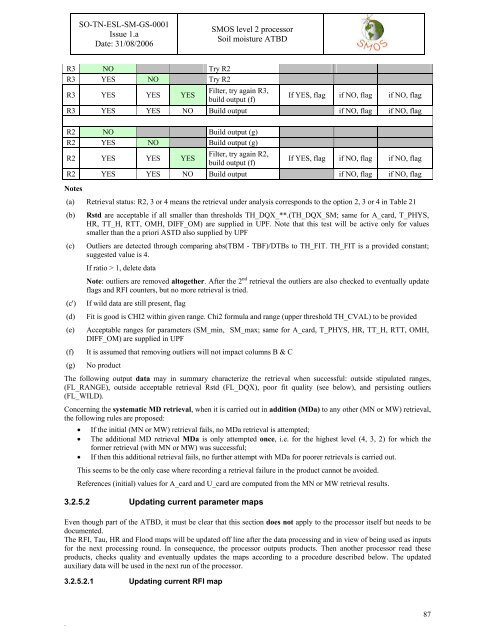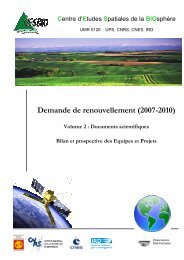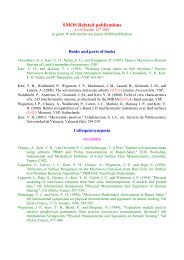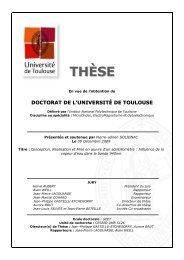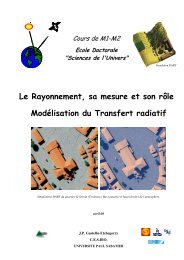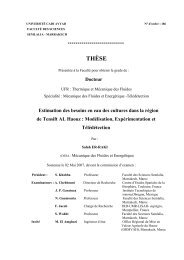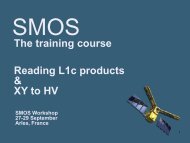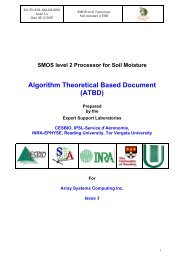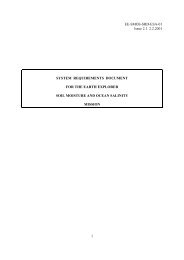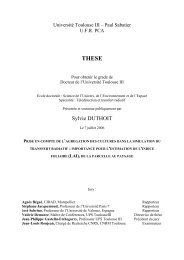Algorithm Theoretical Based Document (ATBD) - CESBIO
Algorithm Theoretical Based Document (ATBD) - CESBIO
Algorithm Theoretical Based Document (ATBD) - CESBIO
Create successful ePaper yourself
Turn your PDF publications into a flip-book with our unique Google optimized e-Paper software.
SO-TN-ESL-SM-GS-0001<br />
Issue 1.a<br />
Date: 31/08/2006<br />
SMOS level 2 processor<br />
Soil moisture <strong>ATBD</strong><br />
R3 NO Try R2<br />
R3 YES NO Try R2<br />
R3 YES YES YES<br />
Filter, try again R3,<br />
build output (f)<br />
If YES, flag if NO, flag if NO, flag<br />
R3 YES YES NO Build output if NO, flag if NO, flag<br />
R2 NO Build output (g)<br />
R2 YES NO Build output (g)<br />
R2 YES YES YES<br />
Filter, try again R2,<br />
build output (f)<br />
If YES, flag if NO, flag if NO, flag<br />
R2 YES YES NO Build output if NO, flag if NO, flag<br />
Notes<br />
(a) Retrieval status: R2, 3 or 4 means the retrieval under analysis corresponds to the option 2, 3 or 4 in Table 21<br />
(b) Rstd are acceptable if all smaller than thresholds TH_DQX_**.(TH_DQX_SM; same for A_card, T_PHYS,<br />
HR, TT_H, RTT, OMH, DIFF_OM) are supplied in UPF. Note that this test will be active only for values<br />
smaller than the a priori ASTD also supplied by UPF<br />
(c) Outliers are detected through comparing abs(TBM - TBF)/DTBs to TH_FIT. TH_FIT is a provided constant;<br />
suggested value is 4.<br />
If ratio > 1, delete data<br />
Note: outliers are removed altogether. After the 2 nd retrieval the outliers are also checked to eventually update<br />
flags and RFI counters, but no more retrieval is tried.<br />
(c') If wild data are still present, flag<br />
(d) Fit is good is CHI2 within given range. Chi2 formula and range (upper threshold TH_CVAL) to be provided<br />
(e) Acceptable ranges for parameters (SM_min, SM_max; same for A_card, T_PHYS, HR, TT_H, RTT, OMH,<br />
DIFF_OM) are supplied in UPF<br />
(f) It is assumed that removing outliers will not impact columns B & C<br />
(g) No product<br />
The following output data may in summary characterize the retrieval when successful: outside stipulated ranges,<br />
(FL_RANGE), outside acceptable retrieval Rstd (FL_DQX), poor fit quality (see below), and persisting outliers<br />
(FL_WILD).<br />
Concerning the systematic MD retrieval, when it is carried out in addition (MDa) to any other (MN or MW) retrieval,<br />
the following rules are proposed:<br />
• If the initial (MN or MW) retrieval fails, no MDa retrieval is attempted;<br />
• The additional MD retrieval MDa is only attempted once, i.e. for the highest level (4, 3, 2) for which the<br />
former retrieval (with MN or MW) was successful;<br />
• If then this additional retrieval fails, no further attempt with MDa for poorer retrievals is carried out.<br />
This seems to be the only case where recording a retrieval failure in the product cannot be avoided.<br />
References (initial) values for A_card and U_card are computed from the MN or MW retrieval results.<br />
3.2.5.2 Updating current parameter maps<br />
Even though part of the <strong>ATBD</strong>, it must be clear that this section does not apply to the processor itself but needs to be<br />
documented.<br />
The RFI, Tau, HR and Flood maps will be updated off line after the data processing and in view of being used as inputs<br />
for the next processing round. In consequence, the processor outputs products. Then another processor read these<br />
products, checks quality and eventually updates the maps according to a procedure described below. The updated<br />
auxiliary data will be used in the next run of the processor.<br />
3.2.5.2.1 Updating current RFI map<br />
.<br />
87


